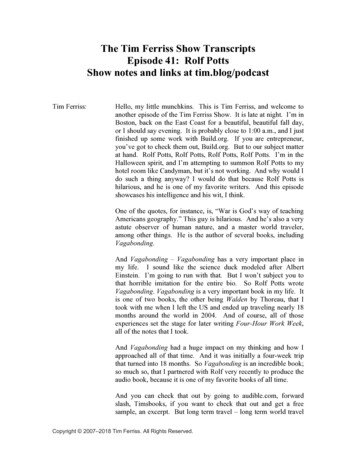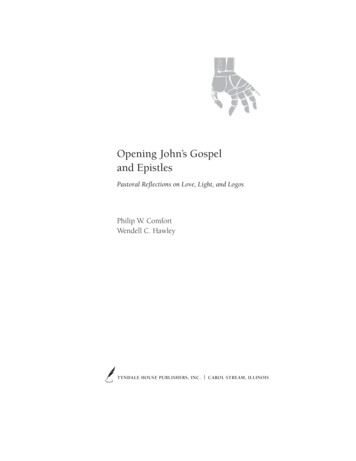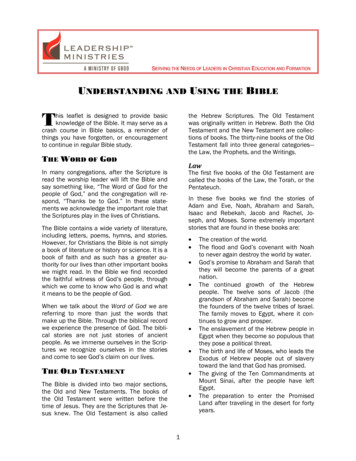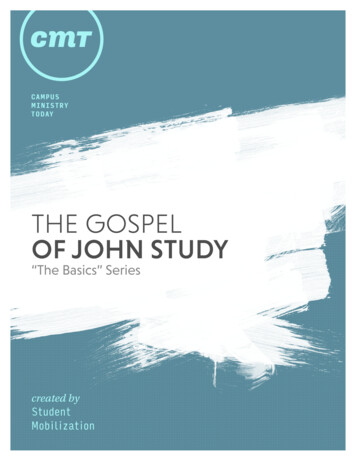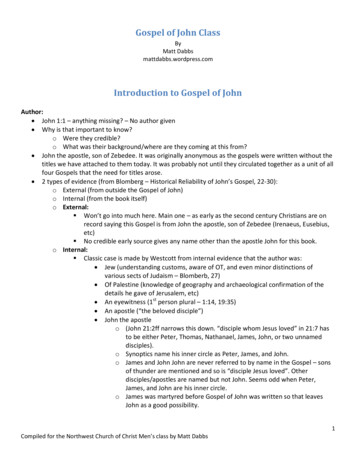
Transcription
To: Dr. John R. Potts MD, FACS ACGME Senior Vice President Surgical AccreditationFrom: William J. Ennis DO, MBA, MMM President American College of Wound Healing and Tissue RepairDate: 7.12.18Dr. Potts,Throughout my 25 year career I have advocated for the creation of a formal specialty in wound care. I, with severalothers, founded a 501c3, the American College of Wound Healing and Tissue Repair (ACWHTR), with the solepurpose of achieving that goal. For eight years the American College of Wound Healing and Tissue Repair has grownits membership, now over 400, held annual meetings and created white papers regarding the importance and lifesaving value of wound care. The organization also facilitates post graduate fellowships in five academic institutions(UIC, Cleveland clinic, Wake Forest, Inova health, Stanford). At my home institution, the University of Illinois atChicago, we have just selected our seventh wound care fellow in as many years. The most recognized woundorganization in the United States, the Wound Healing Society, has endorsed our curriculum and is contemplatingmoving their annual meeting to align with ours each October. The goal of both organizations is to further consolidatethe field, by merging meetings and societies in order to create a needed critical mass of clinicians and providersthereby speaking with one voice.Wound care has become too expensive with much clinical variation and poor evidence. A unified, accepted, andcredentialed fellowship program will provide a path to follow, consistency in training, help standardize care, improveoutcomes and (hopefully) lower cost. In an effort to provide evidence of the need for such specialization, we haveprepared an extensive document that highlights the problem, current status and proposed future state as we haveenvisioned it.Through an agreed upon, consistent educational program, we believe that both the clinical care and safety ofpatients in the US will be improved. (pg. 3-5) There has been an explosion of scientific research and treatmentoptions in the field of wound care. Although many specialties can be involved in wound care, there is minimal specifictraining and education, related to wound care in any of the existing programs. (pg. 17-18) There is an ever growingdemand for physicians to provide wound care full time. Several large practice management companies haveemerged that train and hire wound care physicians over the past several years. These physicians however do notreceive a formal, medical education as they would in other specialties of medicine. There are many clinical andprofessional societies that have developed over the years due to the growing body of clinicians practicing in the areaof wound care. (pg. 28-29) Most training hospitals already have the necessary components required to build asuccessful wound care fellowship program and several now already exist. (pg. 37-41) There are currently 5 programsup and running and the college is in discussions with several more that are interested. As these programs recruitfrom existing residency programs and more fellows are enrolled there is a growing interest in developing newprograms. We anticipate 20 programs would be a good base to allow for sustained growth of this new field initiallyand hope to achieve this within the first 3 years of approval, should that be achieved.As the attached document outlines, the increase in the number and severity of chronic wounds will continue toincrease in years to come. We feel that the ACGME will help provide a path to start the process of standardizingeducational efforts in this new and exciting field.After you have had a chance to review the attached document, I would very much like to have a meeting with youin order to present the formal curriculum documentation that we have put together. The Board and I are excitedabout this opportunity.Sincerely,William J Ennis DO, MBA, MMM
Application to the Accreditation Council for Graduate Medical Education forAccreditation of a Fellowship Program in Wound Healing and Tissue RepairPresented by the American College of Wound Healing and Tissue Repair and theUniversity of Illinois at Chicago7.12.18William J. Ennis, DO, MBA, MMM, CPE, FACOSCatherine and Francis Burzik Professor of Wound Healing and Tissue RepairChief, Section of Wound Healing Tissue RepairDirector, Wound Healing and Tissue Repair FellowshipUniversity of Illinois at ChicagoPresident, American College of Wound Healing and Tissue RepairChicago, IL
2Table of ContentsSectionTopicI.Executive Summary3II.Wound Care: The Problem6III.History of Wound Care19IV.Current Physician Education in Wound Care22V.How Wound Care Fits: Brief History of Medical Specialization24VI.Prior Attempts to Organize28VII.American College of Wound Healing and Tissue Repair30VIII.The Need for ACGME Accreditation39IX.Summary42X.References43Appendix Letter of Support: Wound Healing SocietyPage50
3I. Executive SummaryChronic wounds are an emerging “silent epidemic.”1,2 These non-healing wounds arecommon, costly, and difficult to treat. In parallel with current demographic trends, theprevalence of chronic wounds is expected to grow rapidly in coming years, withcorresponding increases in the already enormous costs of treatment and lostproductivity.2 Treating chronic wounds requires an understanding of complexpathophysiologic mechanisms, multidisciplinary approaches, and an expanding array ofadvanced wound care technologies. Without a dedicated specialist to marshal theseresources, patients may be juggled between disciplines and caregivers, with no expertto coordinate and champion their care. The results are prolonged recovery time, greatercosts of care, further loss of productivity, and increased risk for death.A wound care subspecialty is clearly needed to fill these gaps. This proposal describesthe unmet need for wound care specialists, the currently minimal and unacceptablelevel of wound care education in medicine, and how accredited wound care fellowshipprograms can provide desperately needed standardization and expertise.The statistics establish the need for a wound care specialty. Chronic wounds affect anestimated 6.5 million Americans; millions more may be affected as the population agesand risk factors grow in prevalence.2 Chronic wounds are especially common andimpactful in the most vulnerable people, including the elderly, residents of long-termcare, and patients with common chronic diseases, such as diabetes.3,4 Non-healingwounds also present a significant risk for death; the Agency for Healthcare Research andQuality estimates that pressure ulcers alone cause 60,000 deaths annually in the US.5The direct healthcare costs of chronic wounds total at least 25 billion annually, but thetrue financial impact may be manyfold higher due to prolonged disability, lostproductivity, and reduced quality of life.6,2The vast scope of chronic wounds has fostered the emergence of a large and expandingmarket for wound care products. This nearly 20 billion market comprises more than5000 products, including both traditional (eg, gauze, bandages) and advanced woundcare products.7-10 The advanced wound care market, which represents a broad class ofsophisticated devices, dressings, and skin substitutes, is expected to double in comingyears. The number, diversity, and rapid expansion of wound care technologies mayoverwhelm clinicians who are not wound care experts. The appropriate use of thesetechnologies is further hampered by a dearth of high-quality evidence describing theirclinical use. In the absence of clear guidance and strong evidence, industry steps in withits own research and marketing, further confusing clinicians and the optimal approachto clinical management.The evidence-based management of chronic wounds depends on a multidisciplinaryteam led by individuals with specialized skills and knowledge. Optimal wound care oftendemands surgical, medical, rehabilitative, and other techniques in conjunction withsophisticated wound care devices and knowledge.11-13 The best outcomes occur when
4an individual with expertise in wound care leads and coordinates the treatment team.Indeed, studies of protocol-based treatment by multidisciplinary teams with expertguidance have demonstrated dramatic improvements in outcomes and greatly reducedcosts compared to usual care. In one study, implementation of an evidence-basedwound care protocol at a community hospital led to dramatic improvements inadherence to best practices and reduced average healing time by 50% and treatmentcosts by 75% per patient.14 Together, these findings demonstrate the impact of andneed for expertise in wound care management.Unfortunately, few such experts are available. Variations in wound care derive from alack of formal wound care education, limited high-quality evidence, inconsistentguidelines, and the diversity of clinical techniques used to support wound healing.Recent studies have found that medical students spend only about 10 hours ofeducation on wound-related topics; a scant minority of US medical schools offer aformal wound healing elective.15 Only some residency programs include further woundcare education. The result is that most if not all clinicians who care for chronic woundsobtain their skills and knowledge through the course of clinical practice and withoutspecialized training.Wound care is a considerable clinical challenge. A wound care specialist must grapplewith extensive medical histories, comorbid conditions, potential drug interactions,interdisciplinary coordination, and patient communication and education. Regardless ofeach clinician’s primary training, wound care specialists must draw on knowledge andskills from both surgical and medical fields. The clinician must understand multiplesurgical concepts and techniques, as well as medical disciplines ranging fromdermatology and rheumatology to endocrinology and general medicine. Withoutquestion, the practice of wound management is as challenging, demanding, andcomplex as any field of medicine. The lack of a recognized wound care specialty leavesthe field without experts to guide and coordinate clinical care, lead high-quality researchefforts, and develop rigorous protocols and guidelines.The creation of accredited wound care training programs will benefit clinicians, patients,and the broader healthcare system. Board certification will support the professionaldevelopment of wound care practitioners, facilitate patient access to qualifiedproviders, and allow health systems to ensure the knowledge and competency of theirclinicians. Board-certified experts will facilitate research through academic centers andfoster the development of standardized protocols and guidelines. Because wound careexperts coordinate episodic care (ie, for as long as the wound is healing), the specialtyacts to integrate rather than fragment care and will not introduce new conflicts overpractice territory.The time for accreditation is now. Evidence clearly indicates that a large and expandingpatient population will benefit from care provided by experts with specializedknowledge and skills. And the diverse skills and knowledge required for wound
5management can only be provided through formal training that is currently lackingthroughout the process of medical education.In response to this need, leaders in the field have developed nascent fellowshipprograms at 5 major centers, including the University of Illinois at Chicago, StanfordUniversity, and the Cleveland Clinic. The American College of Wound Healing and TissueRepair continues to encourage the development of wound care fellowships through thesharing of educational content, policies, procedures, and documentation. The College isalso actively establishing a fund to support program development and creating anexamination to be used across all fellowship programs. The ultimate goal is to achieveaccreditation of a wound healing specialty by the Accreditation Council for GraduateMedical Education and certification by the American Board of Medical Specialties. Bydoing so, the College hopes to foster improved understanding and coordinated,standardized care of chronic wounds throughout the healthcare system to reducepatient morbidity and mortality and healthcare costs.
6II. Wound Care: The ProblemSummary Chronic wounds affect 6.5 million Americans2 15%-25% of patients with diabetes will develop a diabetic foot ulcer in theirlifetime16 3% of adults over 80 years of age will develop a venous leg ulcer17,18 Up to one third of patients in acute and long-term care will develop a pressureulcers19 In the US, 60,000 patients die each year due to pressure ulcers5 Prevalence of major risk factors for chronic wounds is rising, including obesity,diabetes, and older age2 Direct costs of chronic wounds are estimated to be 25 billion per year in the US2 Indirect costs of chronic wounds include reduced function, lost productivity, andlower quality of life16,20-22 Multiple gaps in care have been identified, including low-level evidence, limitedphysician knowledge of wound care, and poor use of best practices23-32 Gaps in practice contribute to variation in wound care, longer healing times,increased rates of amputation, and excess costs33,34 Rapidly expanding wound care market includes advanced products that requirespecialized knowledge and skills7-10 Specialized, multidisciplinary care improves outcomes and reduces costs11-13 All of these factors support the need to establish a formal wound care specialtyto coordinate and oversee wound care
7Definition of the problemWounds may result from surgery, trauma, burns, or disease processes. Most acutewounds heal normally and require only basic care. More complex wounds take longer toheal and may require specific management. For example, an infected surgical site,traumatic wound, or burn may require antibiotic therapy, surgical debridement, orother forms of management. Chronic or non-healing wounds most often result fromcommon disease processes, such as diabetes, are associated with significant morbidityand costs, and require the greatest expertise to manage.A chronic wound has been defined as “a disruption of normal anatomic structure andfunction having failed to proceed through an orderly and timely process to produceanatomic and functional integrity, or proceeded through the repair process withoutestablishing a sustained anatomic and functional result.”35 In short, a chronic wound isone that does not progress through the normal healing process in a timely andpredicted manner. The goal of wound management is to facilitate the healing process.Chronic wounds have diverse etiologies and complex patterns of healing. Etiologiesinclude, but are not limited to, trauma, diabetes, vascular disease, ischemia, pressure,infection, autoimmune diseases, and coagulopathies.36 Mechanisms that negativelyaffect the wound healing process include infection, inflammation, impairedangiogenesis, inadequate connective tissue regeneration, excess scar formation, anddelayed remodeling.35,37 Caring for each wound pathology requires expertise frommultiple disciplines and an understanding of each patient’s and wound’s uniquetreatment requirements.36 As a result, the clinical management of chronic woundsrequires a multidisciplinary approach, often including surgical, medical, nursing, andrehabilitative techniques, among others.Without a wound care specialist to coordinate and direct care, patients with chronicwounds may not receive comprehensive and evidence-based management.Burden of chronic woundsChronic wounds are common and costly. Patients with chronic wounds are expensive tomanage and experience significant morbidity and mortality. In one retrospective studyof 1815 outpatients with chronic wounds, 28% died within 2years.38 According to the Agency for Healthcare Researchand Quality (AHRQ), about 60,000 patients each year die asAccording to thea direct result of pressure ulcers.5 Chronic wounds alsoAHRQ, about 60,000cause tremendous suffering, with profound effects onpatients each yearpatients’ physical health, socialization, ability to work, bodydie as a direct resultimage, and level of independence.39 In fact, chronic woundsof pressure ulcers.5have been termed a “silent epidemic,” as they affect a wideswath of the population and burden the health andeconomy of developed countries.2,1
8In the US, about 6.5 million patients suffer from chronic wounds.2 Overall, it is estimatedthat 1%-2% of all individuals will develop a chronic wound during their lifetime.40 Asharp rise in the prevalence and costs of chronic wounds is anticipated based ondemographic trends, most notably the aging population and increasing prevalence ofdiabetes and obesity.2A recently published paper addressed the increasing burden of non-healing woundsthrough the lens of demographic and cost implications.6 This large retrospective studyfound that nearly 15% of Medicare beneficiaries (8.2 million) had at least one type ofwound in 2014. Estimates of total Medicare spending for all wound types ranged from 28.1 to 96.8 billion, with greatest expenditures for the management of surgicalwounds and diabetic foot ulcers.Although chronic wounds may arise from a number of etiologies, most are categorizedas vascular ulcers (venous ulcers and arterial insufficiency wounds), diabetic ulcers, orpressure ulcers.3,4 The most common are venous leg ulcers (VLU), which affect 1% ofthe population and 3% of people over age 80 years. They are the largest single group ofleg ulcers treated in wound care clinics.17 About 7% of VLUs remain unhealed after 5years and 15% never heal or reoccur one or more times. Recurrence rates as high as70% are reported with chronic VLU.18,41,42Diabetic foot ulcers, resulting from a combination of peripheral vascular disease andneuropathy,43 affect as many as 6% of patients with diabetes each year; 15%-25% ofdiabetic patients will have a foot ulcer during their lifetime.16 These ulcers double thecost of care, compared to diabetic patients without foot ulcers, and precede more than80% of lower extremity amputations in diabetic patients.16 Up to a quarter of patientswith diabetic foot ulcers have an amputation; mortality in the years followingamputations may be as high as 50%.44,45 Overall, diabetic foot ulcers have been linked toa 3-year cumulative mortality rate of 28%.44The incidence of pressure ulcers in acute and long-term care ranges from 23.9%-38%.19Pressure ulcers pose significant problems, especially for patients who suffer fromimpaired mobility, inadequate nutritional intake, or a critical illness. For some patients,such as those with spinal cord injury, pressure ulcers are a leading cause of hospitalreadmission and a major source of morbidity and mortality.39 Pressure ulcers also causesignificant impairments in health-related quality of life.46 In an AHRQ study of nursinghome residents, 11% had a pressure ulcer, but only 35% of patients with a pressureulcer of stage 2 or higher received specialized wound care services, as recommended byclinical practice guidelines.47Only 35% of patients witha pressure ulcer stage 2or higher receivedspecialized wound careservices, asrecommended byguidelines.47Economic costs of chronic woundsChronic wounds impose a tremendous burden on thehealthcare system and society. Although estimates ofthe costs of chronic wounds vary substantially, all are
9staggering. For example, a 2009 estimate placed the annual cost of chronic woundmanagement at more than 25 billion in the US alone.2A more recent study (2014) used Medicare and private insurance databases to estimatethe costs of diabetic foot ulcers.16 Compared to matched controls with diabetes,patients with diabetic foot ulcers had many more hospitalization days, home healthcaredays, emergency department visits, and outpatient visits. Incremental annual healthcarecosts were about twice as high – from 11,710 to 16,883 per patient – for patients withdiabetic foot ulcers compared to those without ulcers. Annual work-loss costs related tofoot ulcers exceeded 3,000 per patient. Based on the incidence of foot ulcers amongdiabetic patients – about 6% in some studies – the authors estimated that these woundsadd up to 13 billion per year to healthcare costs.Using similar methods, the same group estimated that the management of VLU costsnearly 15 billion per year in the US.48 Patients with leg ulcers also lose about 2 millionworking days each year.20-22 Similar costs have been reported for the management ofpressure ulcers. In 2011, the AHRQestimated that pressure ulcers cost theAnnual direct costs ofUS healthcare system 9.1- 11.6 billionchronic wounds (billions)per year.5 In 2008, the Centers forMedicare and Medicaid Services (CMS)categorized hospital-acquired pressureHealthcareVenous legulcers as “never events” and modifiedcost due toulcer cost 15Pressure ulcerfoot ulcersreimbursement policies for these 13costswounds, forcing hospitals to shoulder 10the costs of management andincentivizing systems to prevent andeffectively manage these wounds.Even higher chronic wound costs have been proposed. One group estimated that aboutone third of direct annual costs of treating diabetes were linked to the treatment ofdiabetic foot ulcers – totaling nearly 39 billion in 2007.49 In 2012, the AmericanDiabetes Association estimated a total cost of 245 billion for diabetes, of which 176billion were excess healthcare expenditures.50 If one third of this value related todiabetic foot ulcers, the annual cost of this condition might well exceed 50 billion.These expenditures represent a significant portion of the entire healthcare budget. Inthe UK, wound management accounts for almost 4% of total healthcare costs, andwound costs continue to increase.51 Overall, it is estimated that developed countriesdevote 2%-3% of their healthcare budgets to the management of chronic wounds.52The rising tide of chronic woundsDemographic trends describe a sharp rise in the incidence and prevalence of major riskfactors for chronic wounds, such as obesity, diabetes, vascular disease, and older age.
10The US has the highest rates of overweight and obesity in the developed world. Theprevalence of obesity among US adults is about 1 in 3 today, and is expected to reach 1in 2 by 2030, an increase of 65 million obese adults.53 In parallel with obesity, theprevalence of diabetes has risen dramatically. Currently, more than 30 millionAmericans have diabetes, and another 84 million are prediabetic. The rate of diabeteshas tripled in the last 20 years, and projections suggest that as many as 1 in 3 Americanswill have diabetes by 2050.54 Finally, the US population is growing markedly older. TheUS Census Bureau projects that 20% of Americans will be 65 years of age by 2030.55Between 2014 and 2060, the percentage of people aged 65 or older will grow from 15%to 24%, an absolute increase of 9%.As these conditions increase in prevalence, the burden of chronic wounds will alsoincrease, as will the need for specialists trained in evidence-based wound management.Projected annual growth rates for pressure and venous ulcers are 6%–7% in thedeveloped world; diabetic ulcers are growing more rapidly at 9% annually.56
11Wound care marketGrowth in the prevalence of chronic wounds is matched by growth in the wound caremarket. In 2016, the global wound care market totaled 17 billion. It is projected toreach 20.4 billion by 2021, a compound annual growth rate (CAGR) of 3.6%.7 NorthAmerica is expected to retain the largest share of the wound care market, despite rapidmarket expansion in Asia. Projected growth is supported by demographic trends(obesity, diabetes, aging), rising awareness of new wound care technologies, andfavorable government policies.7,8Acting to constrain market growth isGlobal wound care marketthe high cost of advanced wound(billions)care products along with a limitedGlobal marketand inadequately trained provideradvanced woundcare productsbase.(billions) see text 20.40 17Segments within this market include 5.50 10traditional wound dressings andadvanced wound care products.2016202120152022Traditional dressings includeproducts such as gauze andbandages that are commonly used in hospital, long-term care, and home settings. Thesedressings are generally used to cover and protect the wound during the normal healingprocess. Advanced wound care products include film and foam dressings, hydrogels,alginates, hydrocolloids, bioengineered skin substitutes, as well as devices for negativepressure wound therapy and hyperbaric oxygen therapy.57 These products are intendedto be used by specialists to actively support healing of chronic and complex wounds.Advanced wound care products are expected to be the fastest growing segment of thewound care market.7 In 2015, the global market for advanced wound care products wasvalued at 5.5 billion; it is projected to exceed 10 billion by 2022.8,9 Collagen-basedbioactive dressings are forecast to show the highest growth rate within this segment.Four companies (Acelity, Inc., Smith & Nephew, MoLnLycke Healthcare, and ConvaTec)account for 54% of the advanced wound care market globally.9The number, diversity, and rapid development of wound dressings and technologiesmay be overwhelming to most clinicians. Selecting among these options to optimizepatient care requires thorough assessment of wound characteristics and a broadunderstanding of the features, applications, and evidence supporting different woundproducts.10 However, few high-quality trials evaluating wound dressings have beenpublished, and current evidence does not clearly support preference for specificproducts or categories of product.10
12Gaps in wound careStudies have identified wide variation in the clinical care of wounds.33,34 The result isinconsistent treatment, increased costs, and reduced healing rates. Ineffective woundcare also prolongs patient suffering, disability, and loss of productivity.Poor use of evidence-based wound care has been demonstrated in multiple studies. Forexample, although most ( 70%) chronic leg ulcers are venous ulcers, for whichcompression therapy is considered the gold standard, one US study found that only 17%of patients with venous ulcers received this therapy.58,1 Similarly, an analysis of data ondiabetic foot ulcer management from US Wound Registry found that off-loading, acommonly used technique to reduce pressure on the affected appendage, was vastlyunderused in these patients.59 Among 11,784 patientswith 25,114 diabetic foot ulcers, off-loading wasdocumented in only 2.2% of visits over 6 years.One US study found thatPatients managed with total-contact-casting (a loweronly 17% of patientscost, effective form of off-loading) had significantlywith venous ulcersfewer amputations (2.2% vs. 5.2%; P 0.001) and morereceived the goldhealed wounds (39.4% vs. 37.2%). In another study,standard therapy.58only 31% of participants with a lower limb ulcer haddocumentation of an appropriate investigation (ABPIor duplex assessment) in the previous 12 months.11Root causes of gaps in wound careThe roots of variation in wound care are multifactorial (Table 1) and include the lack offormal wound care education, guidelines based on limited evidence, and the diversity ofclinical techniques used to support wound healing, which range from optimal moisturebalance to restoration of blood flow to the wound, compression therapy, infectionmanagement, debridement, and innumerable dressings and medical devices.60-63 As aresult, many clinicians have poor knowledge of wound care, lack wound care skills, andhave limited access to evidence-based guidelines.1 A dearth of standardized carepathways also makes it difficult to track patients with chronic wounds, presenting abarrier to continuity of care. In addition to the myriad treatment options, anothercomplicating factor is the lack data on the best ways to sequence therapies.
13Table 1. Factors underlying gaps in the delivery of wound care. Limited formal wound care education Lack of provider skills and knowledge Lack of standardization Low-level evidence for wound care interventions Guidelines based on limited evidence Poor implementation of best practices Diversity of available wound care products and techniques Lack of recognized wound care specialtyThe preponderance of low-level evidence is a significant challenge. Most clinical woundcare studies are limited by inconsistent inclusion criteria, data measurements, and/orendpoint reporting.23 Multiple Cochrane reviews of wound care interventions haveidentified only limited or low-quality evidence.24-28 A 2012 study compared relevantpublications in the fields of breast cancer and wound care to determine if research intowound care lags behind other specialties.29 Over 5 decades, the authors found a 30-foldincrease in publications on wound care – but a 70-fold increase in publications on breastcancer. High-quality studies (eg, systematic reviews, randomized controlled trials) wereless common in wound care, as were published guidelines (76 on wound care vs. 231 onbreast cancer).Reasonable evidence does exist supporting the efficacy of certain wound careinterventions, such as growth factors, platelet-rich plasma, and skin grafting/tissuereplacement for diabetic foot ulcers.30-32 These more robust trials were the result ofusing a pre-market approval (PMA) pathway to gain FDA approval, not unlike mostpharmaceuticals. The overwhelming majority of wound care products, however, followa 510K pathway through the FDA, which has much lower evidentiary requirements forthe approval process. Even the PMA data were derived from a limited number of studieswith small sample sizes or other design limitations. As a result, clinicians who care forchronic wounds must rely heavily on experts in the field.23An evaluation of guidelines in chronic wound care found that most scored poorly oninde
From: William J. Ennis DO, MBA, MMM President American College of Wound Healing and Tissue Repair . Date: 7.12.18 . Dr. Potts, Throughout my 25 year career I have advocated for the creation of a formal specialty in wound care. I, with several others, founded a 501c3, the American College of Wound Healing and Tissue Repair (ACWHTR) with the sole ,

